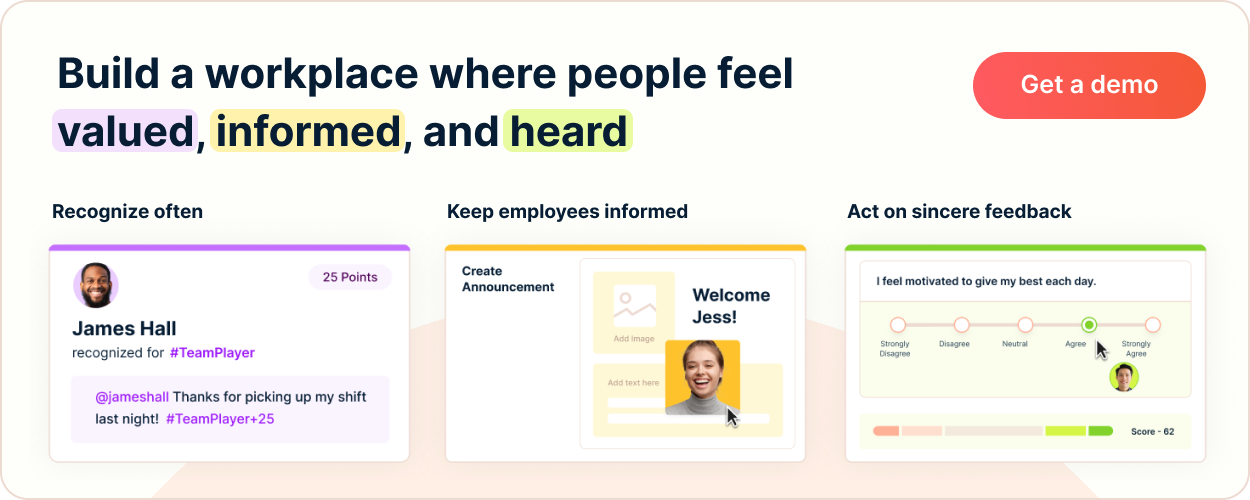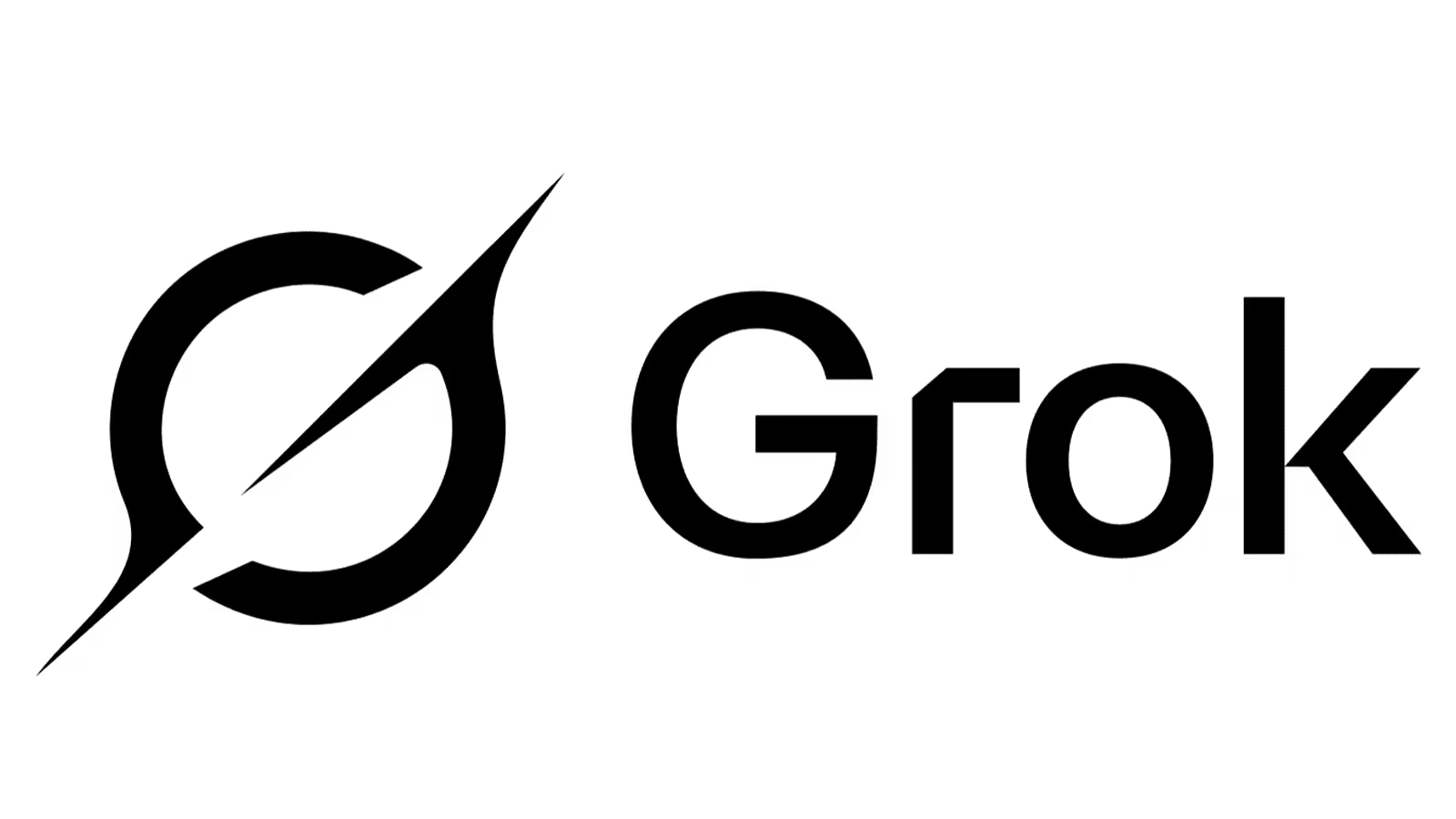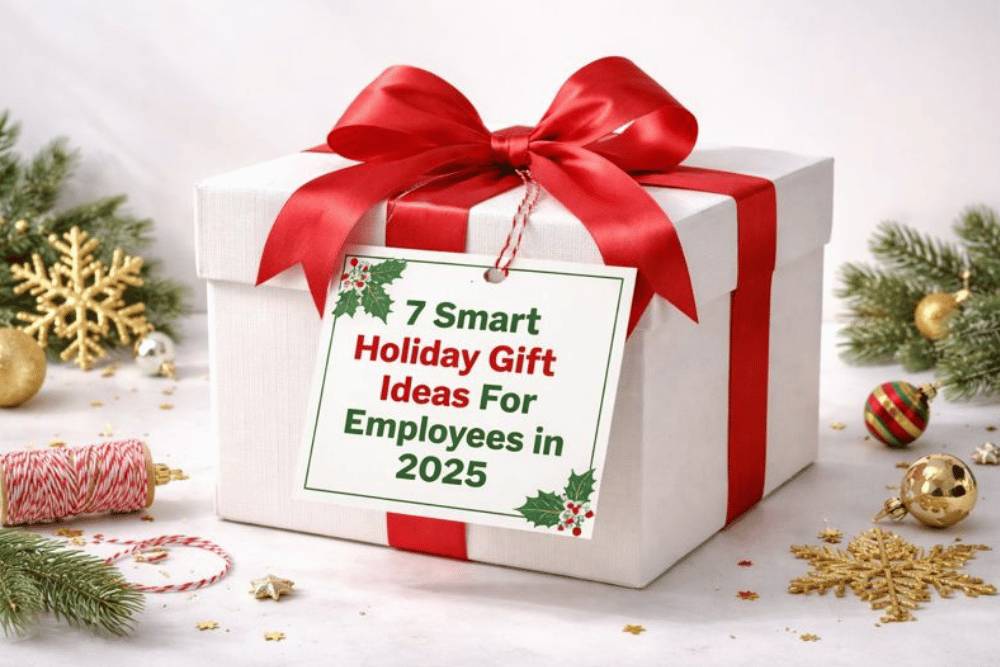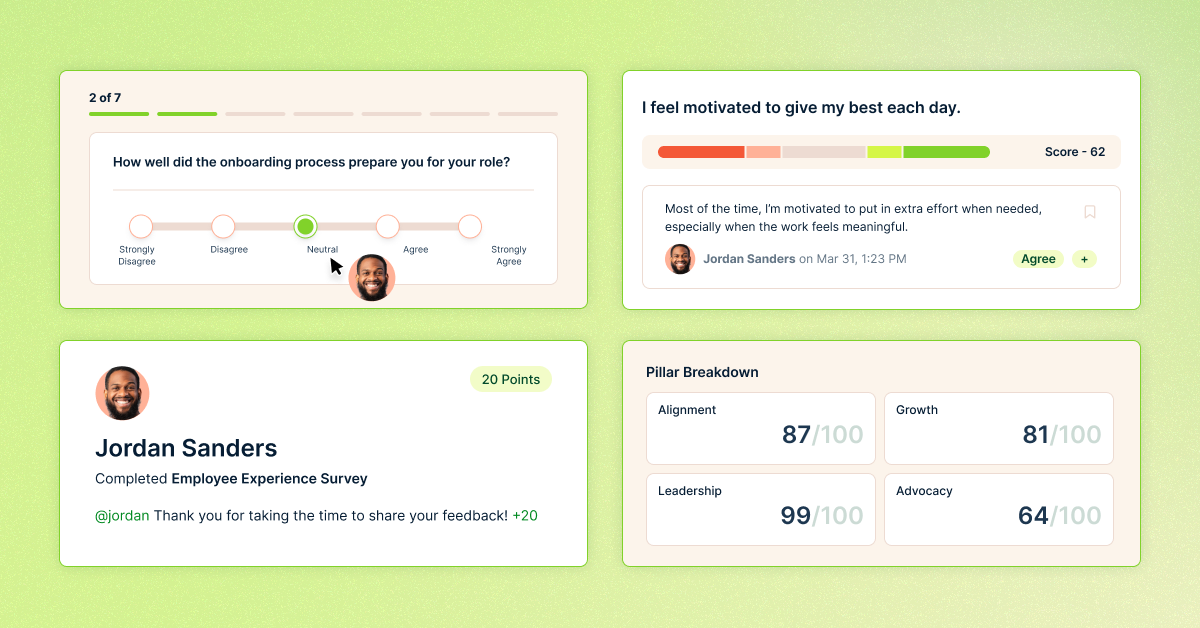Promoting Continuous Improvement by Rewarding Employees Who Embrace Professional Growth

Here's the TL;DR
Creating a culture of continuous learning means moving beyond basic training programs and goal trackers. Growth-focused reward programs incentivize progress, not just outcomes. These programs encourage employees to improve their skills, mentor others, and lead learning initiatives — all while feeling recognized and supported.
What makes growth-focused rewards effective:
- Celebrate certifications, soft skills, and mentorship
- Offer low-cost rewards like shout-outs or extra PTO
- Track development through simple metrics (e.g., certifications, skills applied)
- Link recognition to company values and internal mobility paths
Benefits of a growth-focused culture:
- Higher employee retention (94% say they’d stay longer if development is prioritized)
- Faster skill gap closure and increased morale
- Built-in succession planning and leadership pipelines
To ensure success, companies must:
- Set clear program objectives and growth metrics
- Diversify rewards (monetary, experiential, recognition-based)
- Provide training tools (like LinkedIn Learning or Coursera)
- Communicate through a multi-phase rollout strategy
- Involve and train managers as key advocates
Track success by:
- Measuring KPIs like participation, skill application, and engagement
- Calculating ROI through reduced turnover
- Gathering employee feedback through surveys and focus groups
Growth programs thrive when embedded into daily workflows, championed by leadership, and refined through ongoing feedback.
In today’s fast-paced world, employee training programs are commonplace. Most of us have sat through tedious meetings talking about goal-setting frameworks and, ultimately, tasked with putting them into a goal tracker.
While many companies invest in training programs, few take the next step of developing a continuous learning culture. This culture doesn’t just acknowledge high performance, it recognizes progress, rewards curiosity, and celebrates the pursuit of becoming better.
Understanding Growth-Focused Reward Programs
Employee development plans are commonplace in any organization, big or small. Now, HR leaders are seeing a shift in “run of the mill” employee development plans to more effective growth-focused reward programs.
What is a Growth-Focused Reward Program?
A growth-focused reward program goes beyond just setting goals to hit performance metrics. It is a rewards system that incentivizes employees based on how they improve. These systems are designed to focus on long-term success and building habits for continuous development.
These programs are designed to reward progress, not perfection. Examples can be as simple as:
- Recognizing an employee who completes a certification
- Offering a bonus or perk for mentoring a new hire
- Publicly celebrating someone who led an internal learning session
Benefits of Implementing Growth Rewards
There’s a common business parable about two executives and the importance of investing in employee development.
Executive 1: “What if we train them and they leave?”
Executive 2: “What if we don’t… and they stay?”
Leaders are quickly learning that continuous learning isn’t a nice-to-have, but it’s a differentiator from their competitors. LinkedIn found that a staggering 94% of employees would stay longer if it invested in their career development. Not only do employees say that they’ll stay longer, but employers also see:
- Employees close skill gaps faster
- A culture of proactive learning (vs. reactive learning)
- Increased employee loyalty and higher morale
- Creating a built-in succession planning process can prepare employees for future roles
Common Challenges and Solutions
Developing a culture of continuous improvement doesn’t come without its own challenges and hurdles. Whether it’s challenges from management or employees, you’ll need to champion the importance of these programs and be consistent with them.
Objection #1: How do we track development?
You don’t need to over-engineer this. Start with things that are trackable. How many certifications were completed? Did they attend an external conference? Did they read a leadership book?
Objection #2: What if some roles have more growth opportunities than others?
Try to equalize the opportunities as much as you can. Provide them access to learning resources like LinkedIn Learning to explore additional skills that might interest them. If opportunities are sparse, look to broaden the definition of “growth” from being about position within the company to impact in their role. Things like:
- Mentoring a new team member
- Improving and implementing soft skills
- Learning how another department works
- Leading a presentation to leadership for the first time
- Leading a “tiger team” to solve a problem
Objection #3: We can’t afford big incentives. OR We don’t have it in the budget
Start with low-cost recognition options that are still meaningful. When an employee completes a certification, you could give them points through completing a challenge, provide an extra day of PTO as a custom reward, or do a personal shout-out during an all-hands.
Designing Your Reward Program
Your reward program is where theory turns into action. As you create the foundations of this program, you’ll want to make sure that you’re intentional, the program is measurable, and will scale with your organization as it grows and evolves.
Setting Clear Objectives
To avoid confusion and limit frustrations, your employee reward programs should be clearly defined. These expectations and objectives help both the company and the employee align on needs. For example, you can let employees know that this program is designed to:
- Reduce skill gaps in key roles
- Increase internal mobility
- Develop a succession plan for future leadership roles
Identifying Growth Metrics
Companies that track their learning outcomes are 3x more likely to outperform other organizations. So what does growth look like?
Growth metrics should go beyond just “checking the box” and should showcase skill building, contributions to the team, and consistent stretch behavior. Metrics could include things like:
- Certifications completed
- Skills learned and applied
- Cross-training participation
- Mentorship involvement
- Internal courses created or trained on
You could also link these to your company's mission and core values to help reinforce a continuous improvement mindset across the organization.
Types of Rewards and Incentives
Each of your employees has different tastes, interests, hobbies, and motivations. One may be driven by monetary rewards. Another may be motivated by public praise and shoutouts. Creating a diversified option for rewards can provide options to motivate every employee.
Not all rewards need to be expensive and big. HBR found that while big rewards do incentivize people to complete the task, small rewards are great ways to cause intrinsic motivation and get employees to make changes autonomously. The most impactful ones feel personal, earned, and aligned with how your people want to grow.
Budget Considerations
No matter the size of your company, budget is usually a concern for people. However, budget anxiety shouldn’t kill your recognition ideas. In fact, 55% of employees said that employee engagement is driven by nonfinancial motivators. Growth-focused rewards can be extremely cost-effective when done correctly.
If the budget is tight, start small with peer-to-peer or manager recognition and publicly shout out employees who are doing a great job. You can also use Nominations as a vehicle to celebrate multiple employees at once without breaking the bank. You can also check out some budget-friendly employee appreciation ideas.
Key Components of Successful Growth Programs
Now that you understand the “why” behind professional growth plans and what to consider when designing them, it’s time to build one. A growth-focused rewards program only succeeds when it’s embedded into your employees’ everyday experiences. If it feels Frankenstein’d on or is an afterthought, then it will fail.
Learning and Development Opportunities
One of the most crucial parts of a successful growth program is to create opportunities for real, sustained career growth. Employees need access to development opportunities. Don’t just encourage employees to capitalize on these opportunities, but provide them options to seek them out.
An astonishing 86% of employees say that job training is important to them, and 74% of them are willing to learn things outside of work to help improve their job performance. As an organization, you can offer a mix of formal and informal courses (utilize internal training or a site like Coursera), increase opportunities for cross-training, or provide more opportunities to lead on projects or present to leadership.
Skill Acquisition Tracking
To formalize the program, you may want to develop a way to measure learning and track new skills. This isn’t designed to be punitive, but a way to recognize progress and effort for employees. Skills tracking should be more about validating an employee's growth. Employees want to know that their development is being noticed by their manager, HR, and others within the company.
Tracking skills doesn’t need to be an overly complex process. You can:
- Track goals in your performance management or OKR system
- Create a simple dashboard that shows skills earned or applied
- Use progress logs, journals, or 1:1 tracking with their manager
Recognition Systems
To scale your growth program, you’ll want a tool to help alleviate some of the administrative burden. Receiving recognition reinforces the positive employee behaviors you want. Look for systems that allow you to:
- Automate milestones
- Create employee growth challenges
- Give public or private shout-outs
- Options for peer-to-peer or top-down shoutouts
- Tie recognition to your company's core values
- Give custom awards for growth or professional development
Career Advancement Pathways
As employees grow, they’ll want to know where this is leading them. Is it a promotion? A role shift? What? You need to show your employees that, as they grow, there are real opportunities opening up within the company.
Help employees see their internal mobility paths. You can utilize role frameworks with skill requirements (moving from an L3 to an L4) and what the new roles, responsibilities, and compensation would entail. Your managers should also be trained on how to have these conversations with employees. Teach them how to incorporate these conversations into your semi-annual performance reviews and 1:1s with employees.
Implementation Strategy
Even the best-designed programs will fail without a plan and strong buy-in from leadership. Rolling out your professional growth plan requires intention, clarity, communication, and consistent reinforcement. If employees don’t understand it, managers don’t know how to support it, or it falls flat after a couple of months, it’ll erode credibility, and momentum will come to a halt.
Program Launch Steps
With any change management process, you’ll want to have a plan on how to roll this out to your organization and team. To begin, you’ll want to:
- Start with one team to pilot it, gather feedback, and iterate on it.
- Define the program's roles. Who will own communication? Who will track metrics? Etc
- Create an internal wiki with FAQ, resources, and rules
- Determine how you’ll communicate this to employees. Will you hold a town hall? Send an email? Hold individual office hours?
- Make sure that leadership is bought in and will reinforce the importance of the program
Communication Plan
On average, it takes 5-7 repetitions for something to stick with someone or for them to take action. So, telling people once in an email isn’t enough. A clear, multi-touch plan can help build awareness, buy-in, and alleviate roadblocks before they become an issue. Employees don’t resist change, they resist confusion.
Create a communication plan with distinct phases - pre-launch, launch, and follow-up communications.
- Pre-launch - Teasers in Slack, email, or company meetings talking about the new program. Help raise employee awareness on what will be coming and what they should know at launch. Talk with managers in leadership meetings about the importance of this and how to reinforce the messaging.
- Launch - At launch, send out an email, video, and resources to the team. Holding a town hall with a company-wide Q&A with individual office hours can be helpful if you want to go above and beyond.
- Follow-up - Post launch, you can highlight success stories through emails or company meetings. When employees see consistent examples, they’re more likely to do it.
Training Managers
The success of your program will live and die with your managers. Managers are the bridge between your vision and your employees’ day-to-day experience.
Gallup found that the biggest variance in team engagement is determined solely by the manager. So, while your managers don’t need to be experts on the program, they should be advocates. The easier that you make it for them, the more likely their employees will follow through
Monitoring and Feedback
After you’ve launched your program, it’s not “set it and forget it.” You need regular check-ins, feedback, and tweaks to keep it relevant and effective. A good program evolves and shows people that you’re listening and acting on their feedback.
To collect the feedback, try implementing:
- Quarterly program reviews
- Surveys and focus groups to hear from employees
- A dedicated Slack/Teams channel for real-time input
- Adjust rewards/criteria based on what you learn
- Semi-annual or annual updates to the program
Measuring Program Success
Now that you’ve built and rolled out your program, it’s time to show that it’s having an impact. If you don’t measure it, then it’s like it didn’t happen. Worse is that it if you can’t prove that it’s working, it probably won’t get funded again.
Key Performance Indicators
Key Performance Indicators (KPIs) are the specific metrics that tell you whether or not the program is working. You’ll want to measure several different metrics to get a holistic view of the program.
- Participation rates in learning opportunities
- Completion of development milestones (certifications, industry awards, stretch projects)
- Manager's feedback on employee readiness and performance
- Changes in engagement scores
Note: Don’t get distracted by vanity metrics. For example, instead of listing that 100 people completed an LMS training this quarter. Track the metric that 85% of employees who completed the ‘Effective Communication’ training showed improvement in manager-rated communication skills within 60 days.
ROI Calculation
Unlike a Sales team, measuring the ROI for HR can be difficult. Oftentimes in HR, you’re not measuring the dollars in, but trying to measure the dollars out, or what could have gone out. When you can tie your efforts back to dollar signs, you’ll get the attention of the C-suite.
One common metric HR teams tie back to is reducing voluntary turnover. Replacing an employee can cost anywhere from 40% (frontline employee) to 200% (senior leader) of their salary in lost productivity. So saving that $50,000 frontline employee from quitting could theoretically save your company $20,000 in lost productivity and revenue.
Employee Feedback Methods
The numbers matter, but it’s the stories behind them that move people to act. Gather feedback through post-launch pulse surveys, 1-1 manager-employee feedback, employee focus groups, or other methods. Hearing from employees not only helps them feel heard, but also lets you know what’s working.
Program Adjustment Strategies
Even great programs need some tweaks. Set aside time each quarter or semi-annually to review the program and make any needed adjustments. You’re employees (and the company) are growing and evolving, and so should your program.
Best Practices and Tips
The best growth programs aren’t the flashiest. The best programs are consistent, inclusive, and people-centered. As you roll out your program, here are a few tips and tricks to help you out.
Case Studies
As you roll out your growth program to employees, share some case studies or stories about other companies that have done this and the benefits it has had for their employees. For example, Google’s 20% free time policy or AT&T’s “Future Ready” program that allowed them to reduce external hiring by 40%
Common Pitfalls to Avoid
It’s hard to avoid every problem in a roll-out; however, here are some often well-intentioned but avoidable missteps.
- Overly complicated reward criteria
- Focusing on only the top performers
- Letting the program run on autopilot
- Lack of leadership alignment
Long-term Sustainability
Your growth program should be built like your company - it’s able to evolve and adapt to the changing environment and business needs of your employees and customers. Treat it like a product. Improve it over time based on data and feedback.
Building a growth-focused rewards program isn’t just about recognizing effort — it’s about reinforcing the kind of culture where learning, development, and progress are celebrated every day. When you reward growth, you retain talent, close skill gaps, and build a future-ready workforce.















